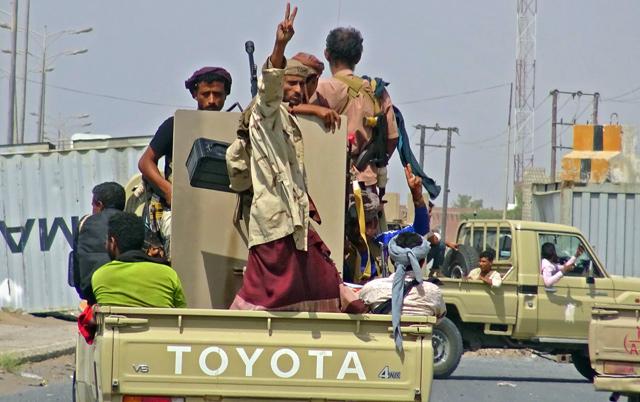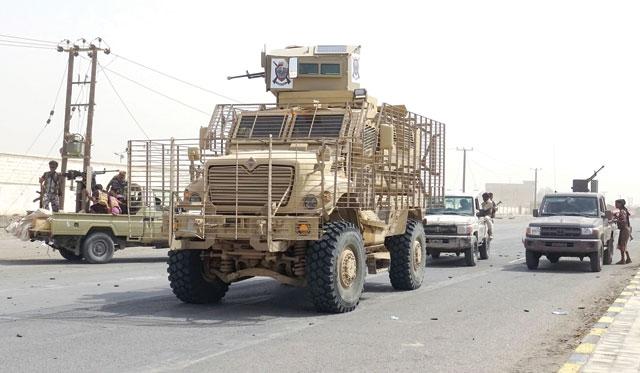You are here
Clashes reach residential streets in Yemen’s Hodeida
By AFP - Nov 11,2018 - Last updated at Nov 11,2018

Yemeni pro-government forces gather on the eastern outskirts of Hodeida as they continue to battle for the control of the city from Houthi rebels on Saturday (AFP photo)
HODEIDA, Yemen — Fighting for control of Yemen's rebel-held city of Hodeida reached residential streets on Sunday, as the Houthi insurgents mounted fierce resistance to government forces backed by Saudi Arabia, military sources said.
Fears for civilian safety have been rising since November 1, when the loyalist forces renewed an operation to take Hodeida. The Red Sea port city has been in the grip of Yemen's Iran-backed Houthi rebels since 2014.
Mariam Aldogani, Save the Children's field coordinator in Yemen, said that the people in Hodeida are living in a "state of fear".
"There is ongoing fighting, and the situation is very bad," she told AFP on the phone, as strikes were heard in the background.
"There is a lot of fear among residents, and some fear keeping their [loved ones] in hospitals as battles intensify," said Aldogani, about a kilometre away from the port.
Health facilities in Hodeida are receiving an increasing number of wounded civilians, she added.
Troops entered residential streets in eastern Hodeida Sunday with the aim of "purging them of insurgents", according to a pro-government military official.
Rebels entrenched in the streets and positioned on rooftops battled to keep loyalist fighters out of a neighbourhood located between two major landmarks in Hodeida, the city's main hospital and vegetable market, both essential to the daily lives of civilians.
Residents south of the site of Sunday’s clashes said they could hear gunfire and shelling throughout the night.
“We had three people from our neighbourhood hospitalised over the weekend for shrapnel wounds,” said Marwa, who asked that her name be changed.
“We’re really tired. It’s not safe. We have no money. This time no one is leaving. We can’t afford it, and it’s too dangerous.”
Battles on Sunday intensified in the southwestern part of the city as pro-government forces advanced along the coast towards the port, military officials told AFP.
Yemenis across the city have reported seeing snipers stationed on rooftops and rebel-run tanks firing artillery in Hodeida, home to the impoverished country’s most important port.
Saudi Arabia and its allies first launched an offensive to take Hodeida in June, sparking an exodus from the densely populated city.
The operation was temporarily suspended amid UN efforts to hold peace talks, which failed to materialise. The United Nations is now pushing for talks by the end of the year.
Yemen’s foreign minister said on Sunday that his government, which is recognised by the UN, was committed to the peace talks.
“The government is committed to supporting the UN special envoy’s efforts... to hold a round of talks by the end of this year,” Khalid Al Yamani was quoted as saying by the state-run Saba news agency.
Fears for port
Pro-government fighters moved into the neighbourhood between the May 22 Hospital — the largest in Hodeida — and Sanaa Road, which links the port city to inland Yemen.
Fighters clashed around the Al Waha [Oasis] Resort hotel complex, closing in on a civilian district located south of the hospital and north of Sanaa Road.
Hodeida’s docks, while under blockade, were not yet impacted by the fighting, according to a local official.
“We cannot predict what will happen in the future, but at the moment there are no problems,” Yahya Sharafeddine, deputy director of Hodeida Port, told AFP.
Hodeida is a vital lifeline for Yemenis across the war-torn country, as the majority of imports and humanitarian aid enter through its port.
Around 14 million Yemenis are at risk of famine and many more are dependent on international aid, according to the UN.
Hodeida port has been blockaded by the Saudi-led alliance since November 2017 over what the coalition says is arms smuggling from Iran to the Houthis. Tehran denies the charge.
Sanaa international airport, held by the rebels, is also under blockade by Saudi Arabia and its allies who control Yemen’s airspace and maritime borders.
In the first defection from Sanaa, where the rebels run a parallel government not recognised by the UN, Houthi minister Abdul Salam Ali Jaber on Sunday announced he had deserted the insurgency.
Hundreds dead
More than 400 combatants have been killed in 10 days of clashes in Hodeida.
Medics on Sunday said at least 61 fighters had been killed over the course of 24 hours, with dozens of wounded taken to hospitals outside the city.
Medics in Hodeida city reported 43 Houthi rebels and nine loyalists were killed in clashes over the same period.
Another nine loyalist fighters were killed and their bodies taken to a hospital in government-held Mokha, south of Hodeida, medics said.
Dozens of wounded rebels were transferred to hospitals in the provinces of Sanaa and Ibb, further inland, a source at the Hodeida military hospital said.
In 2014, the Houthis overran the capital Sanaa and swept though much of the rest of the country, triggering the Saudi-led intervention the following year.
The rebels have since been driven out of virtually all of the south and much of the Red Sea coast, with the exception of Hodeida.
Both parties in the Yemen conflict stand accused of acts that could amount to war crimes.
The Saudi-led coalition has been blacklisted by the United Nations for the maiming and killing of children, including an attack that killed at least 26 children south of Hodeida.
The United States on Saturday said it halted a controversial refuelling arrangement for coalition aircraft engaged in Yemen.
The World Health Organisation estimates nearly 10,000 people have been killed in the war since 2015, while rights groups believe the toll may be five times as high.
Related Articles
HODEIDA, Yemen — At least 150 people have been killed in 24 hours of clashes in the Yemeni port city of Hodeida, medics said on Monday, as B
ADEN — Saudi-led coalition air strikes in Yemen have killed almost 80 Houthi rebel fighters over 48 hours in the w estern province of Hodeid
SANAA — The UN envoy for Yemen landed in rebel-held Sanaa Monday for talks aimed at shoring up a truce between rebels and a government allia

















